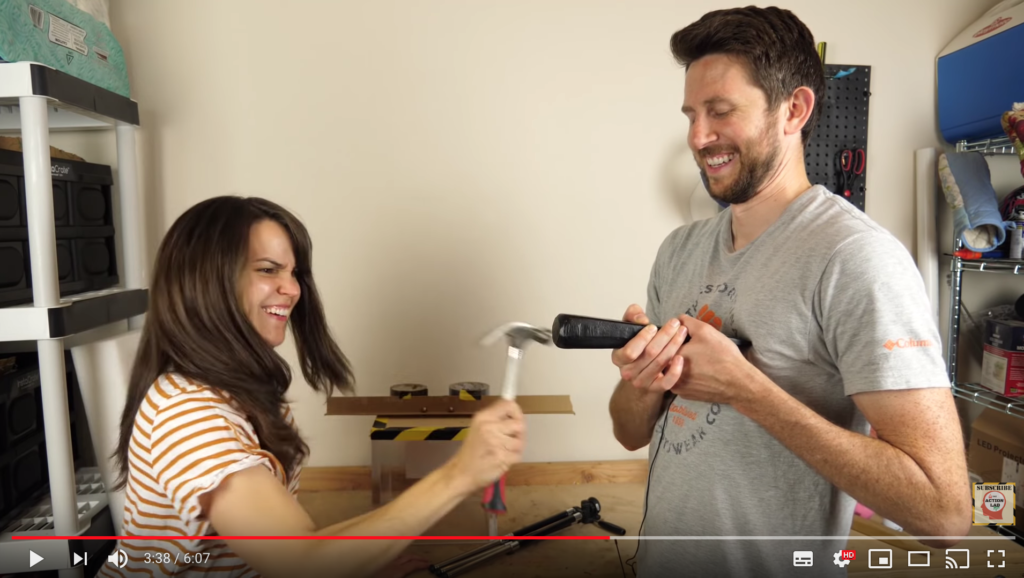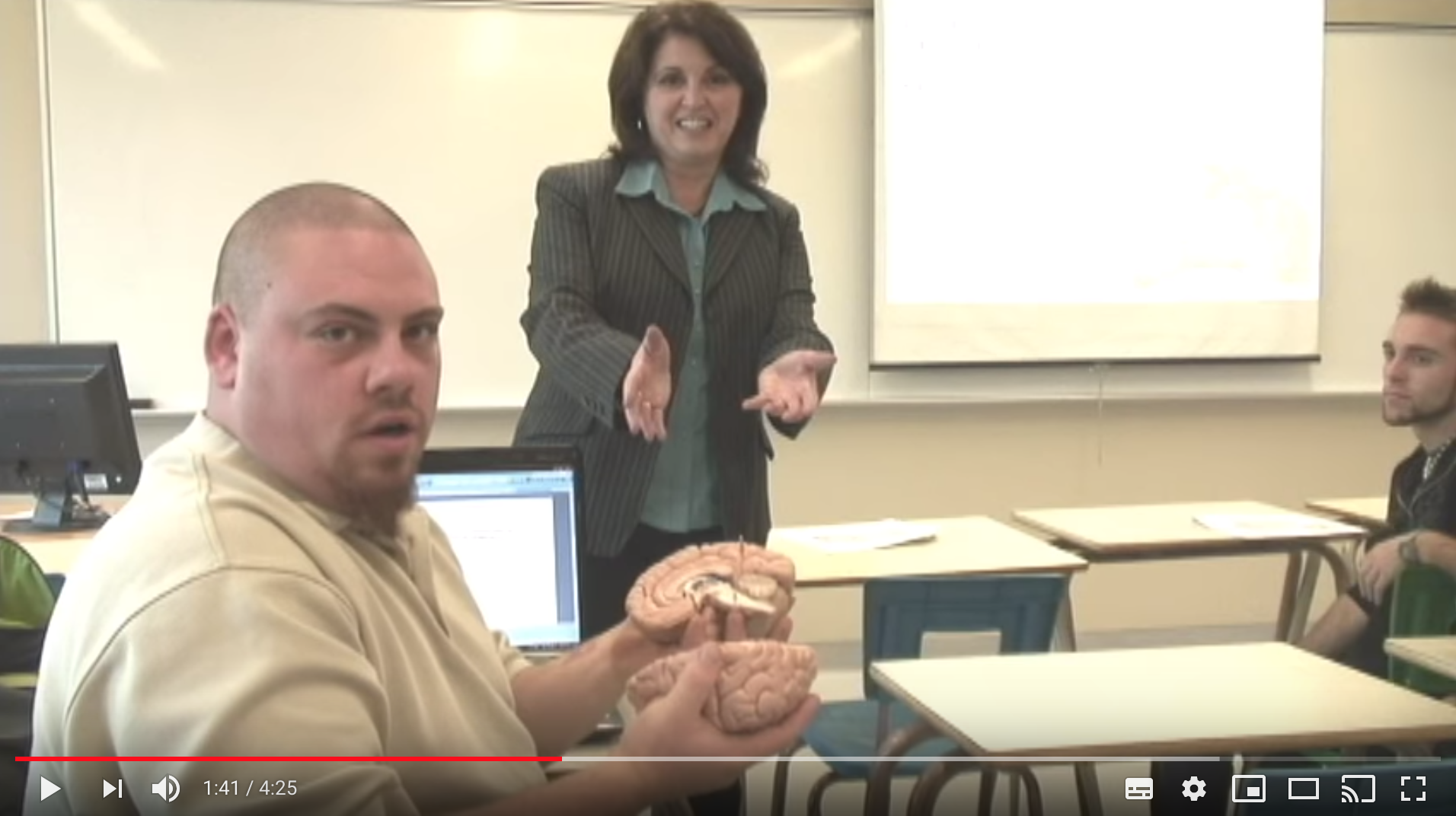Chapter 8: Pedagogical differences between media
8.4 Video

![]()
8.4.1 More power, more complexity
Although there have been massive changes in video technology over the last 25 years, resulting in dramatic reductions in the costs of both creating and distributing video, the unique educational characteristics are largely unaffected. (More recent computer-generated media such as simulations, will be analysed under ‘Computing’, in Section 8.5).
Video is a much richer medium than either text or audio, as in addition to its ability to offer text and sound, it can also offer dynamic or moving pictures. Thus while it can offer all the affordances of audio, and some of text, it also has unique pedagogical characteristics of its own. Once again, there has been considerable research on the use of video in education, and again I will be drawing on research from the Open University (Bates, 1984; 2005; Koumi, 2006) as well as from Mayer (2009).
Click on the links to see examples for many of the characteristics listed below.
8.4.2 Presentational features
Video can be used to:
- demonstrate experiments or phenomena, particularly:
- where equipment or phenomena to be observed are large, microscopic, expensive, inaccessible, dangerous, or difficult to observe without special equipment (see an example from the University of Nottingham);
- where resources are scarce, or unsuitable for student experimentation (e.g. live animals, human body parts) (see an example of the anatomy of the brain, from the University of British Columbia);
- where the experimental design is complex (for example, testing whether wild sharks are more attracted to blood than fish oil)
- where there is an element of risk or danger in conducting the experiment (see an example demonstrating the conservation of momentum)
- where the experimental behaviour may be influenced by uncontrollable but observable variables;
- illustrate principles involving dynamic change or movement (see an example explaining exponential growth from a course at UBC);
- illustrate abstract principles through the use of specially constructed physical models, for instance an animation of a normal curve of distribution;
- illustrate principles involving three-dimensional space, for example, see this video from Nova Scotia Community College
- demonstrate changes over time through the use of animation, slow-motion, or speeded-up video (see an example of how haemophilus influenzae cells take up DNA, from UBC);
- demonstrate correct procedures in health, safety, repairs and maintenance (for an example, see Brady’s EMR Skills Video)
- substitute for a field visit, by:
- providing students with an accurate, comprehensive visual picture of a site, in order to place the topic under study in context; for instance see the Bodo aboriginal archeological site in Alberta
- demonstrating the relationship between different elements of a system under study (e.g. production processes, ecological balanc brady’s EMRe); for example, see the paper-making process
- by identifying and distinguishing between different classes or categories of phenomena at the site (e.g. in forest ecology);
- to observe differences in scale and process between laboratory and mass-production techniques;
- through the use of models, animations or simulations, to teach certain advanced scientific or technological concepts (such as theories of relativity or quantum physics) without students having to master highly advanced mathematical techniques; see for instance ‘Einstein’s Theory of Relativity Made Easy.’
- bring students primary resource or case-study material, i.e. recording of naturally occurring events which, through editing and selection, demonstrate or illustrate principles covered elsewhere in a course;
- demonstrate ways in which abstract principles or concepts developed elsewhere in the course have been applied to real-world problems, for example, innovative stormwater management in the University of British Columbia’s Master of Land and Water Management;
- synthesise a wide range of variables into a single recorded event, e.g. to suggest how real world problems can be resolved;
- demonstrate decision-making processes or decisions ‘in action’ (e.g. triage in an emergency situation) by:
- recording the decision-making process as it occurs in real contexts;
- recording ‘staged’ simulations, dramatisation or role-playing, as in the scenarios in Ryerson University’s Therapeutic Communication and Mental Health Assessment Program
- demonstrate correct procedures in using tools or equipment (including safety procedures);
- demonstrate methods or techniques of performance (e.g. mechanical skills such as stripping and re-assembling a carburetor, sketching, drawing or painting techniques, or dance);
- record and archive events that are crucial to topics in a course, but which may disappear or be destroyed in the near future, such as, for instance, street graffiti or condemned buildings (see an example about neon lights in Vancouver);
- demonstrate practical activities to be carried out by students, on their own (for example, see 32 cool experiments to do at home).
![]()

![]()
8.4.3 Skills development
This usually requires the video to be integrated with student activities. The ability to stop, rewind and replay video becomes crucial for skills development, as student activity usually takes place separately from the actual viewing of the video. This may mean thinking through carefully activities for students related to the use of video.
If video is not used directly for lecturing, research clearly indicates that students generally need to be guided as to what to look for in video, at least initially in their use of video for learning. There are various techniques for relating concrete events with abstract principles, such as through audio narration over the video, using a still frame to highlight the observation, or repeating a small section of the program. Bates and Gallagher (1977) found that using video for developing higher order analysis or evaluation was a teachable skill that needs to be built into the development of a course or program, to get the best results.
Typical uses of video for skills development include:
- enabling students to recognize naturally occurring phenomena or classifications (e.g. classroom teaching strategies, symptoms of mental illness, classroom behaviour) in context;
- enabling students to analyse a situation, using principles either introduced in the video recording or covered elsewhere in the course, such as a textbook or lecture; for example, possible raw material on managing domestic violence,
- interpreting artistic performance (e.g. drama, spoken poetry, movies, paintings, sculpture, or other works of art);
- analysis of music composition, through the use of musical performance, narration and graphics;
- testing the applicability or relevance of abstract concepts or generalisations in real world contexts (see for example the European Space Agency’s video on climate change)
- looking for alternative explanations for real world phenomena.
There are many ways in which video can be used for skills development. Nevertheless, however video is used for skill development, as well as the demonstration of the skill, attention must be paid to ensuring opportunities for student practice and feedback, probably using other media, although it is now increasingly easy for students to make their own videos to demonstrate their skill.
![]()

![]()
8.4.4 Strengths and weaknesses of video as a teaching medium
One factor that makes video powerful for learning is its ability to show the relationship between concrete examples and abstract principles, with usually the sound track relating the abstract principles to concrete events shown in the video (see, for example: Probability for quantum chemistry, UBC). Video is particularly useful for recording events or situations where it would be too difficult, dangerous, expensive or impractical to bring students to such events.
Thus its main strengths are as follows:
- linking concrete events and phenomena to abstract principles and vice versa;
- the ability of students to stop and start, so they can integrate activities with video;
- providing an alternative approach to the presentation of content that can help students having difficulties in learning abstract concepts;
- adding substantial interest to a course by linking it to real world issues;
- a growing amount of freely available, high quality academic videos;
- good for developing some of the higher level intellectual skills and some of the more practical skills needed in a digital age;
- the use of low cost cameras and free editing software enables some forms of video to be cheaply produced.
It should also be remembered that in addition to the features listed above, video can incorporate many of the features of audio as well.
The main weaknesses of video are:
- many faculty have no knowledge or experience in using video other than for recording lecturing;
- there is currently a limited amount of high quality educational video free for downloading, because the cost of developing high quality educational video that exploits the unique characteristics of the medium is still relatively high. Links also often go dead after a while, affecting the reliability of outsourced video. The availability of free material for educational use is improving all the time, but currently finding appropriate and free videos that meet the specific needs of a teacher or instructor can be time-consuming or such material may just not be available or reliable;
- creating original material that exploits the unique characteristics of video is time-consuming, and still relatively expensive, because it usually needs professional video production;
- to get the most out of educational video, students need specially designed activities that often will have to sit outside the video itself;
- students often reject videos that require them to do analysis or interpretation; they often prefer direct instruction that focuses primarily on comprehension. Such students need to be trained to use video differently, which requires time to be devoted to developing such skills.
For these reasons, video is not being used enough in education. When used it is often an afterthought or an ‘extra’, rather than an integral part of the design, or is used merely to replicate a classroom lecture, rather than exploiting the unique characteristics of video.
8.4.5 Assessment
If video is being used to develop the skills outlined in Section 8.4.3, then it is essential that these skills are assessed and count for grading. Indeed, one possible means of assessment might be to ask students to analyse or interpret a selected video, or even to develop their own media project, using video they themselves have collected or produced, using their own devices.
References
Bates, A. (1984) Broadcasting in Education: An Evaluation London: Constables
Bates, A. (2005) Technology, e-Learning and Distance Education London/New York: Routledge
Bates, A. and Gallagher, M. (1977) Improving the Effectiveness of Open University Television Case-Studies and Documentaries Milton Keynes: The Open University, I.E.T. Papers on Broadcasting, No. 77 (out of print – copies available from tony.bates@ubc.ca)
Koumi, J. (2006). Designing video and multimedia for open and flexible learning. London: Routledge
Mayer, R. E. (2009). Multimedia learning (2nd ed). New York: Cambridge University Press
The University of British Columbia also provides two annotated bibliographies of digital multimedia research. one collated at UBC and one by the University of Central Florida.
Activity 8.4 Identifying the unique pedagogical characteristics of video
1. Take one of the courses you are teaching. What key presentational aspects of video could be important for this course?
2. Look at the skills listed in Section 1.2 of this book. Which of these skills would best be developed through the use of video rather than other media? How would you do this using video-based teaching?
3. Under what conditions would it be more appropriate for students to be assessed by asking them to analyse or make their own video recording? How could this be done under assessment conditions?
4. Type in the name of your topic + video into Google.
- How many videos come up?
- What’s their quality like?
- Could you use any of them in your teaching?
- If so, how would you integrate them into your course?
- Could you make a better video on the topic?
- What would enable you to do this?
Here are some criteria I would apply to what you find:
- it is relevant to what you want to teach;
- it demonstrates clearly a particular topic or subject and links it to what the student is intended to learn;
- it is short and to the point;
- the example is well produced (clear camera work, good presenter, clear audio);
- it provides something that you could not do easily yourself;
- it is freely available for non-commercial use.
For feedback on this activity, and some further comments on the value of video, click on the podcast below:

